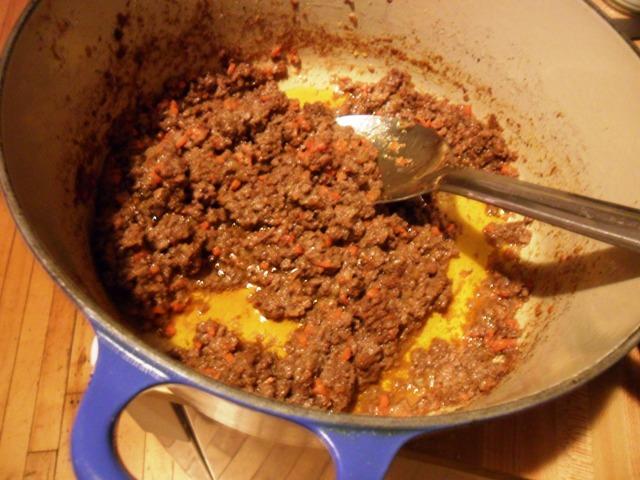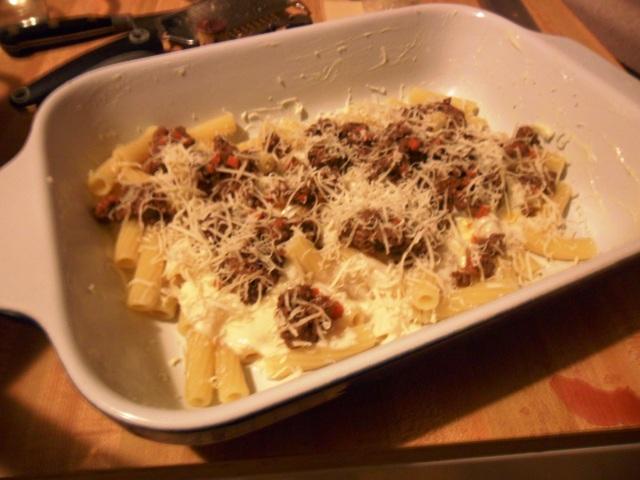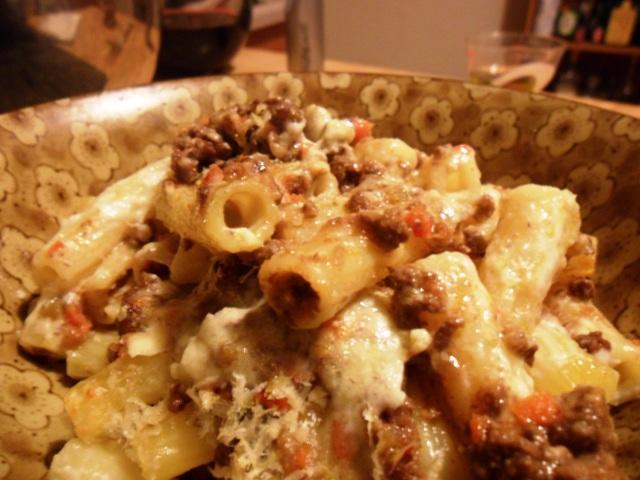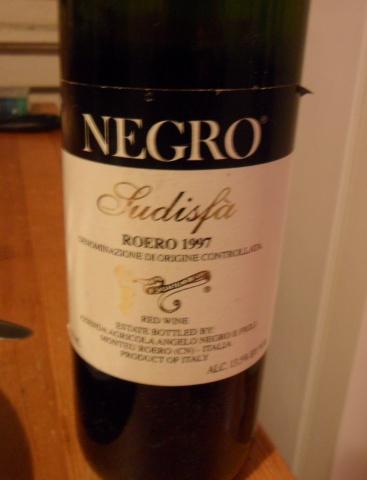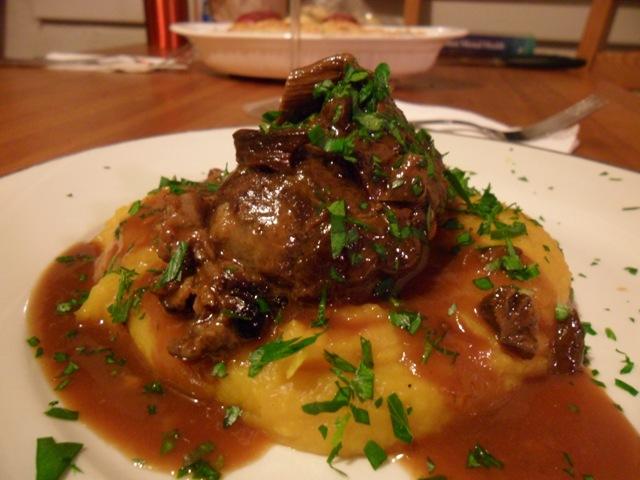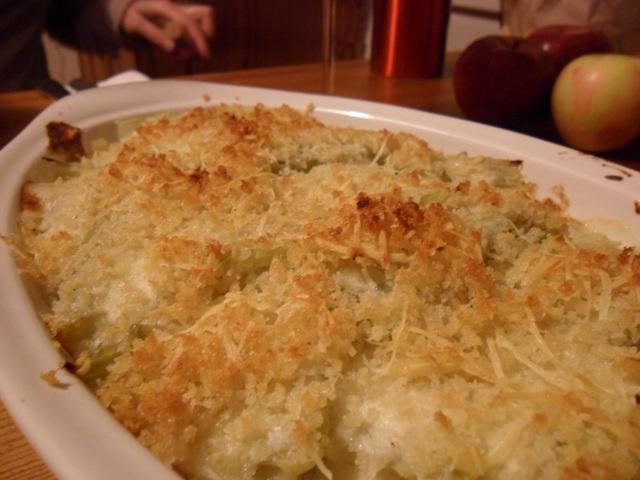-
Posts
644 -
Joined
-
Last visited
Content Type
Profiles
Forums
Store
Help Articles
Everything posted by Alcuin
-
This is the way I poach everything (fish, chicken, hardboiled/softboiled eggs) but for some reason I never tried it with eggs out of the shell. I've done about a dozen eggs this way over the past week after reading this thread. It works every time, even with average eggs of questionable age and without acidulating the water. This is the easiest most consistent method. Thanks for the tip!
-
Smile bemusedly in self-satisfaction while simultaneously cursing under one's breath that one can't get a decent Cock-tail around here. Yes or smiling, cursing, and also dreaming of a world where I could get a straightforward mixture of cold booze, bitters, and a little sugar in a glass at even the lowliest of bars (especially at the lowliest of bars!).
-
I think you'll find it most pleasin' I did, with 2 dashes xocolatl mole bitters and an orange twist. I'll definitely be making that one again thanks.
-
I don't think I'd be alone here in saying I'm going to agree to disagree on that. We've had this discussion in this very thread time and again, no need to rehash it. But the idea that both of those drinks are equally entitled to the name "Old Fashioned" is by no means universally accepted. All power to those who like fruit paste in their whiskey, no offense to them intended. But then what do you do about the fact that many people think of the newer style complete with mangled fruit salad as The Old Fashioned? Maybe it's the fact that I'm in WI, where the new style reigns supreme and everybody knows the drink, but unless they're initiated into some of the cocktail trends of the past seven or so years, the garbage OF is The OF to them. You have to explain at length why what you're serving them is in fact an Old Fashioned. I'm not sure you can beat back the tide of the many people for whom that is an OF. As for me, last night I had 2oz Genevieve, 2 dashes of Bittercube Jamaica#2 bitters, a squirt of syrup, some ice cubes and a thick swatch of blood orange peel weeping profusely its aromatic oils, and I call that an Old Fashioned. But I wouldn't serve that to somebody, call it an OF and that's that. I'd have to explain why I am entitled to call it an OF. In that case, the shoe's on the other foot even if I think they're mistaken in what the true ideal of an OF is. For this reason, I like to say Old School OF if I'm talking the true version and Old Fashioned when I'm talking the new school version (and explaining to them why I'm giving them the Old School version!). Old School Old Fashioned [Whiskey Cock-tail] seems rather redundant to me. I've never refused to mash up fruit in the bottom of someone's drink (and believe me I've done it in all manner of drinks upon request), I just wouldn't offer that as an Old Fashioned, without qualification. My standard position has been to make it without fruit and add it in later if demanded. I've rarely had an involved discussion if neither me nor the customer wanted it. Something along the lines of "this is the original, and I think, best way to make this. Give it a shot, but if you don't like it I'll gladly add fruit or soda if you'd like" has sufficed. Usually not an issue down here, though I can understand why this might be more of an issue in WI where the drink never really went away and sort of became it's own ideosynchratic thing. As for other spirits, I'm all for it. At Fino we had an "Oldest Fashioned" which allowed a choice of Rittenhouse BIB, Ransom Old Tom, Smith & Cross, or Laird's Bonded. It's a great way to explore any quality spirit. I like the idea of adding the fruit in later. I'm not a bartender though so I don't have to worry. I do use it to introduce people to cocktails by explaining to them how we got from the OF then to the OF now (as most people understand it). The OF is totally the quickest gateway toward the perspective that sees the addition of vermouth as an innovation and thinks in terms of base spirit rather than mixer. It's this inversion, starting at the Cock-tail and thinking forward till now and thinking in terms of elevating the base spirit rather than blinding the palate with a rainbow of mixers, that separates the truly afflicted from your average drinker. Also, Smith&Cross Old Fashioned is happening tonight! Thanks for the idea; for some reason it never occurred to me.
-
I don't think I'd be alone here in saying I'm going to agree to disagree on that. We've had this discussion in this very thread time and again, no need to rehash it. But the idea that both of those drinks are equally entitled to the name "Old Fashioned" is by no means universally accepted. All power to those who like fruit paste in their whiskey, no offense to them intended. But then what do you do about the fact that many people think of the newer style complete with mangled fruit salad as The Old Fashioned? Maybe it's the fact that I'm in WI, where the new style reigns supreme and everybody knows the drink, but unless they're initiated into some of the cocktail trends of the past seven or so years, the garbage OF is The OF to them. You have to explain at length why what you're serving them is in fact an Old Fashioned. I'm not sure you can beat back the tide of the many people for whom that is an OF. As for me, last night I had 2oz Genevieve, 2 dashes of Bittercube Jamaica#2 bitters, a squirt of syrup, some ice cubes and a thick swatch of blood orange peel weeping profusely its aromatic oils, and I call that an Old Fashioned. But I wouldn't serve that to somebody, call it an OF and that's that. I'd have to explain why I am entitled to call it an OF. In that case, the shoe's on the other foot even if I think they're mistaken in what the true ideal of an OF is. For this reason, I like to say Old School OF if I'm talking the true version and Old Fashioned when I'm talking the new school version (and explaining to them why I'm giving them the Old School version!).
-
That's as it should be at a diner, though maybe not at a "diner"... There's a local restaurant conglomerate around here that has several "diners," one of which actually has "blue plate" right in the name (every thing does come on a blue plate too). It's more of a "diner" themed restaurant than anything, but the prices aren't so bad for what you get. The problem is, these places aren't as cheap as a real diner and they aren't as good as very many of the real restaurants around here. There are too many good breakfast or burger places around to merit thinking of going there. For instance, while this "diner" does serve a lot of local, organic, gluten free food, so does every other breakfast place around here and there are plenty of burger places that do too. The "diner-themed-restaurant" seems too doomed to a kind of pitch perfect mediocrity, maybe even the most high quality mediocrity of a sort your money can buy.
-
I know they are in the thrift shops but Kerry Beal and I have been looking for ages and even in the thrift stores it's hard to find ones that are not: Too shallow Too small Too ornate We will keep looking and I am sure the perfect coupes will show up but they do seem to be in short supply. Edited to add missing verb. That's too bad. There are at least three or four every time I hit the one store down the street from where I live (I'm only counting the ones that are suitable). And I know there are other people looking there too, so there must be more. Maybe they've just been more popular around here. Then again I like them small, and I do have some that are a bit shallow but they're not too bad. But the vast majority of my drinks are 3oz pre-dilution. If you need them for bigger drinks than that, you might have to go with one of the coupes on the market that are bigger (and tend to have bigger price tags too...). All the coupes I find tend to be the same small size.
-
That looks a whole lot like a Libbey Embassy coupe... Anyway, this might not be what you're looking for, but there are boatloads of coupes of all shapes and sizes in thrift stores. I think its because they are a popular glass for weddings or other occasions when champagne is served, or they were back in the day and found their way out of an estate and into the thrift shop. You might have to look around but they're there, and sometimes you'll get some really pretty ones with etching. If you don't like the Libbey coupe, your best bet is to hit the thrift stores.
-
We drank a bottle of Infinium the other day and this pretty much covers just what I thought about it. The bubbles are nice, comparable in texture to a nice sparkling wine. It's a sparkling beer and it is what it is on its own account. I didn't feel that it was trying to be champagne any more than a high end cider like Aeppel Treow is. Aeppel Treow actually does strike the palate in a similar way to wine but like the Infinium I think sparkling wine's the inspiration but item not the goal to make beer or cider into wine. I liked it and thought it was interesting but don't think I'll be trying it again. If you are a beer/wine enthusiast and not hard up for cash, I'd recommend trying it if you can get your hands on it. It's just interesting enough. I liked Sam Adams' Utopias too but not enough to seek it out again either. For my $18 for the Infinium, it was worth trying but I can buy two six-packs of Two Hearted or a bottle of Aeppel Treow with money to spare next time. But if you think Infinium is over the top expensive, you should check out the price for a bottle of Utopias...
-
I don't know anything about that Loire sparkler, but I assume it's all chenin blanc right? If so, for cocktails the richness of chenin blanc doesn't dry up a drink as much as a typical champagne might. So if you're making a drink recipe that depends on the sparkler to dry up the drink, you might have to tweak it. Try making something like a French 75 and see if you need to adjust it if the sparkler you have is fruitier. That will provide you a nice baseline to get a feel for how the wine will work in drinks and it will show you some things about the wine you might not notice otherwise. While the extra fruit might be less apparent when tasted neat, for instance, it can really throw off the balance of a drink. I think it is a mix of Chenin Blanc, Chardonnay and other white wines from the region since it is classified as a Blanc de blanc but I suspect you are right that it may not be as dry as most champagne despite being classified as a brut. The Rose definitely has a little more sweetness to it. I will have to play with a bottle as you suggest and see. But at about $8 a pop that is easy enough to do! One small correction. The website says: Colombard 40%, Sauvignon Blanc 40%, Chardonnay 20% Funny enough I stopped by the wine shop today and this wine was sitting on the counter ready to be shelved. I didn't taste it, but I've been told it's a bit drier than a typical Loire blend and with that bill of varietals that makes sense. Should be more acidic than anything 100% chenin with the Colombard and Sauvignon blanc. Sounds like a great deal that should work well with cocktails. Always good to do some tests, if only for the tester's satisfaction, but it does sounds like a winner on any account. Would have bought a bottle myself if there was a cold one around...
-
I don't know anything about that Loire sparkler, but I assume it's all chenin blanc right? If so, for cocktails the richness of chenin blanc doesn't dry up a drink as much as a typical champagne might. So if you're making a drink recipe that depends on the sparkler to dry up the drink, you might have to tweak it. Try making something like a French 75 and see if you need to adjust it if the sparkler you have is fruitier. That will provide you a nice baseline to get a feel for how the wine will work in drinks and it will show you some things about the wine you might not notice otherwise. While the extra fruit might be less apparent when tasted neat, for instance, it can really throw off the balance of a drink.
-
Everybody thinks of Champagne when thinking of sparklers, and Champagne is the undisputed king. But the quality of sparklers from other regions can be outstanding. Cremant de Bordeaux and cremant de Bourgogne can be very good, and relatively very cheap. There's a cremant de Vouvray I really like, confusingly called Tete de Cuvee but it's really nice chenin blanc applely fruitiness produced with methode champenoise. You won't get the pin point bubbles and the exciting feel of true champagne from these wines. They were initially called cremant because they had a creamier texture (bigger bubbles). They are closer to a champagne now, but still have a little of that creaminess. If you take them for what they are, they are great. And since they're cheaper, you can drink them more often and even pair them with food on a weekday! That said, I'll be drinking L'Allier grand cru over the holidays...
-
The thing that turned me off of the food processor was the heat that built up because of the work the machine had to do to beat the dough. That heat really throws off the process, and it is very noticeable. I would try to produce doughs that should have been naturally cool to the touch but they weren't because of the heat the machine gave off. These days, I either use the mixer or my hands.
-
The great thing about formulas for baking is that it puts you well within the ballpark for what the bread should be like. You shouldn't have to tweak too much; if you do, the formula is flawed because it's not getting you close enough to the bread the formula should produce. With the right formula, you should be able to bake that bread and get a reasonably good to great result. From there, you can work on your bread whispering instincts to go from good/great to excellent/outstanding. But for the novice baker, worrying too much about protein percentages is a factor that might be over complicating the process. My advice is to buy some AP flour, whatever you like (I was using Gold Medal until I switched to KA when it went down to a comparable price). Then bake with that and when you can see where you can make improvements on the finished product, make them. If you can't see where to make the improvements, keep baking until you can. And after all, some bread sage or other said that with bread baking, even what seem to be your worst efforts look to other people like something pretty great: fresh baked bread!
-
Hydration percentage is still useful. It provides a baseline hydration for different kinds of breads, and it provides benchmarks for you if you're just starting out. As a baseline for hydration, you're going to do say 72% for a country boule and go from there. The feel that you might develop will allow you to tweak that but in my experience unless your conditions are extreme you won't have to. Most times, I just go with my 72% and stick with it instead of fiddling with the dough. 72% is well within the zone (except for on extremely humid days though, for an example of when I might add some tablespoons of flour). As a benchmark, 80% hydration provides a very slack dough for ciabatta, while something like 55% makes a firm dough for bagels. It's good to have the numbers in your head when you're thinking about your bread because it allows you to break down the components of the bread to understand the formula while also helping you correct the formula for ambient conditions or fix other parts of it if it goes wrong (baker's percentages don't just cover hydration-everything is reckoned as a percentage of the flour making it easier to command the formula). I found it very useful for helping me understand breads and I still think through the ratios even though I've developed a decent feel for the different types of dough.
-
This is a very overused wine term in my opinion. It is still useful though in the right contexts. Wine/spirits tasting terms are often more evocative than descriptive. When someone talks about wet cement notes in tequila, they're not suggesting that wet cement is delicious even if it is a positive component in a tequila. If you want to taste a classically earthy wine to see what you can see about it, check out a Chinon from the Loire valley. Chinon's (100% cabernet franc) tend to be earthy. That is, to my palate, there's a taste that's reminiscent of dust or dustiness typically on the finish. The palate tends to be nice red fruit, so you might have to concentrate on looking for the earthiness towards the end of the taste but it will likely be there if you go with a Chinon (they're not cheap though...). Many people use the term "earthy" as a kind of catchall, which isn't really helpful. It's a good descriptor though, when you find a wine that actually exhibit's the quality. But if you can't taste it, it either isn't there or it doesn't matter. See if you can find a good winestasting in your area: if you really want to get into it, the best way to learn is to taste a lot of wines, ideally several at a time (and if you can taste say several different bottles of the same kind of wine at one time, even better). But always just drink the wines you like, and like what you like about them.
-
I remember reading somewhere (can't find it now) around the internet an account of a trip to Domaine Tempier in which the winemaker there talks about drinking very old rose (like 20 years old). He says that the wine can stand up to it, but of course it becomes something different than the original intention of the rose. This is probably true for the winemaker at Domaine Tempier, with access to some of the best rose in the world and lots of it from many different ages. But as others have said, rose's not made to be aged. Drinking 20 year old rose is like exploring the boundaries of what's possible, but it's not like drinking rose. I've drunk 5-6 year old Alsatian pinot blanc that was drinkable, with fruit still intact and even some acidity. I've also had similarly aged wines that shouldn't see that kind of age and they have nothing to them, no fruit and no acidity. The wine had completely fallen apart. White wines that stand up to age have very high acidity and sweetness, like rieslings or champagne or Sauternes. More delicate whites (i.e. most whites) can't stand up to age and/or don't need it. Most wines, red or white, are made to be drunk young and the benefit of aging more than a few years would likely not be worth it. There are some that really need it (e.g., Barolo, Burgundy, Cahors) because these wines need to mellow out a bit so that they aren't all acidity/tannins all the time getting in the way of appreciating the subtlety and complexity of their flavors. You can speed up the process by decanting and so oxygenating the wine, but that only takes you so far. You want to age them (then when they are old, you protect them from oxygenation because they become more delicate, it's a balance that way). But this doesn't go for every wine. Your average $10-15 everyday drinker is very likely made to be taken home and enjoyed that night, and something like rose is made to be enjoyed effortlessly on a hot day by the grill. (Though they are great year round too of course and can be very complex--I think they can be great bang for the buck).
-
I've never done a cook-off here before, but yesterday it was cold and snowy and I needed something long cooked and rich. So I made some Bolognese sauce and used it in a baked dish I found in Marcella Hazan's _Essentials of Classic Italian Cooking_. Here are the ingredients for the sauce: I used half the onion, and chopped it as finely as I could along with the stalk of celery and the carrot. I sweated the onion, then added the celery and carrot and cooked them together. Then I added the beef, 1 full pound of it (maybe a bit too much, but I wanted the dish to be ribsticking), and broke it up finely with a fork. Then I added a cup of milk and some nutmeg and cooked it down, then a cup of red wine and cooked that down, then I added a cup of crushed tomatoes. I then let it cook for about 3 1/4 hours and make sure the seasoning is right. This is essentially Hazan's procedure with a little more beef than she uses and a little less tomato. I like to use white wine, because its got more acidity to contrast to the richness of the beef and milk, but I had some leftover red so that's what went in. The acidity of the tomatoes was enough anyway. Here's the result: You can see that there's quite a bit of fat in this sauce. That's what clings to the pasta, and I think the fat is essential to the sauce. You can see too that it is purely a meat sauce: if you didn't know there were tomatoes in it, you might not be able to tell. The tomatoes and wine are there to balance the milk and the beef. It's an intensely beefy, very rich tasting sauce: meager ingredients elevated to the point of luxury. I used the sauce, along with two cups of loose besciamella, grated Grana Padano, and a pound of rigatoni. In Hazan's recipe, she mixes the Bolognese and the besciamella, but I like to keep them separate somewhat. They blend together during baking, but not too much so there are pockets of pasta dressed with one sauce or the other, or both together. After baking for about 15 minutes at 400F, here was the result: It is not at all diet food, but it is rich, hot, and delicious for a cold night.
-
No I'm not very old, and the avatar was chosen in a time when the late 8th early 9th century scholar Alcuin of York loomed large in my dissertation. That avatar is a picture of him, depicting him as abbot which was his job after he retired from his job as teacher at Charlemagne's Palace school. And yes they were $1, amazingly. I only wish I could have carried more.
-
The wine I was given ended up being quite good for drinking, though this wine doesn't have too many years left in it to be at its peak. In fact, it may be only ever so slightly over the hill. But though it may be on the downswing, it's tasting good now. I should have known it would still be good. It's nebbiolo, clearly sturdy enough to last. We drank it with pork cheek simply braised in white wine, a small amount of tomato, some mirepoix (strained out when I degreased), and thyme. To the sauce I added those mushrooms I was gifted. The pork I served over butternut squash puree (sweat some onions, add cubed squash, add a touch of water, and cook until soft then puree in a food processor, adding some butter and seasoning; I added some garam masala for a little spice to go with the pork). With it we had cardoon gratin. I added some bread crumbs to help make a topping along with some bechamel for creaminess. Sometimes I just to cream and parmigiano, sometimes I just do bechamel. This time I decided to add the bread crumbs. The cardoons were good, and I have plenty of them left. They have a light artichoke flavor, which I think will be really nice with some bagna cauda. I'm going to do that with the rest I think, maybe tomorrow.
-
I just got back from doing the wine tasting I help out at every Saturday (pays for most of my weekly wine). Jim, the owner of the store, has been clearing out some inventory. I told him what I was making tonight and he gave me some old nebbiolo from '97. I'm going to see if it's any good: could be great, could be over the hill. Also, while I was there a friend stopped by and gave me some reconstituted porcini mushrooms (he made too much), so I took them off his hands and added it to my braise of pork cheek. On to dinner!
-
No problems with sodium here. I think I actually saw a salt potato kit (consisting I think of salt, and potatoes) in a grocery store around here. I should really make that. The best thing to eat while camping if you come back from a long hike is potatoes wrapped in foil roasted on the fire, with copious amounts of salt and butter. No matter the potato or the butter, it is transcendent.
-
"Peruvian purple" is one type that keep their color. I've had those, they're really good. But very small, right? Or maybe I'm thinking of a different Peruvian potato (I think there are thousands of varieties of potatoes in Peru, so I'm probably thinking of a different one). Looking back at the pictures, it looks like they had Purple Majesty that's blue inside and Adirondack Red that's pink inside. I'm intrigued enough to go back next week and try those pink ones out my self.





